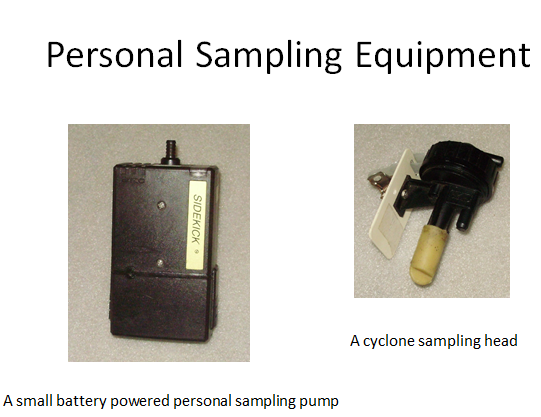5.1 Measurement of Exposure
If significant levels of exposure to RCS are possible it may be necessary to carry out personal monitoring of exposed workers to determine the exposure levels and what exposure controls are required. Using this technique the amount of RCS in the air that the worker is breathing in can be measured and this measurement can be compared with the OEL as part of the risk assessment. Personal monitoring is a specialised task that will need to be carried out by a suitably competent person such as a qualified occupational hygienist.
Personal monitoring involves placing a filter to trap the RCS dust in the breathing zone of the worker. The filter is held in a cyclone sampling head which separates the respirable particles from the larger non-respirable particles. Air is drawn through the filter using a small battery powered air pump. Once the sampling is complete the filter is sent to a specialist laboratory to have the amount of crystalline silica dust collected measured.

An approved method for taking the air sample and for analysis of the sample by the laboratory should always be used. Examples of these methods are listed in the Further Sources of Information Section of this manual. The concentration of dust in the air breathed in by the worker is then calculated by dividing the weight of crystalline silica collected by the volume of air drawn through the filter.
Calculation of the Level of Exposure
The level of exposure is calculated using the following equation:
C = W/V
where C is the concentration of dust measured in mg/m3 ,
W is the weight of crystalline silica collected on the filter measured in mg ,
and V is the volume of air drawn through the filter in m3
As the OEL is an 8 hour time weighted average the measured concentration will need to be adjusted if the time the worker is exposed to RCS is more or less than 8 hours. This is done by multiplying the measured value by the exposure time expressed as a fraction of 8 hours as shown in the equation below.
C8hrTWA = E/8 x Cm
where C8hrTWA is the 8 hour time weighted average exposure in mg/m3 ,
E is the time the worker is exposed to RCS during the working day in hours,
and Cm is the measured concentration in mg/m3
If the measured 8 hour time weighted exposure is above the OEL, or if observation or existing information suggests that the level of exposure could be reduced using simple methods, action needs to be taken to put in place appropriate control measures.
As with all risk assessments where a significant hazard is present the risk assessment should be recorded and reviewed on a regular basis to ensure that controls are effective and the workers are protected.
Answer the questions below to test your understanding of measurement.
Decide if the following statements are true or false.
Is the following statement true or false?
Feedback
True
The way that workplace exposures are measured is by using personal monitoring techniques.
Feedback
True
The dust in the breathing zone is what the worker will be breathing in.